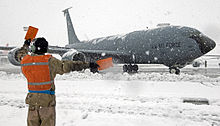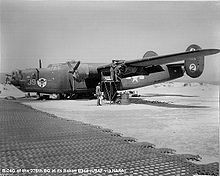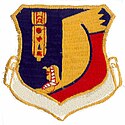376th Air Expeditionary Wing: Difference between revisions
mNo edit summary |
→Mission: edited and expanded |
||
| Line 35: | Line 35: | ||
==Mission== |
==Mission== |
||
The 376th Expeditionary Wing is responsible for providing air combat power projection throughout the CENTCOM Area of Responsibility, including tactical airlift and air refueling, principally in support of OPERATION ENDURING FREEDOM. C-17 and KC-135 aircraft are involved in this effort. Additionally, the wing serves as a hub for strategic airlift operations and as an intermediate staging base for transiting personnel and equipment in support of operations in Afghanistan. The wing hosts transient forces from coalition nations, as well as transient forces of the United States Army, Marine Corps and Navy.<REF>[http://www.manas.afnews.af.mil/library/factsheets/factsheet.asp?id=4690 376th AEW Factsheet]</REF> |
The 376th Expeditionary Wing is responsible for providing air combat power projection throughout the CENTCOM Area of Responsibility, including tactical airlift and air refueling, principally in support of OPERATION ENDURING FREEDOM. C-17 and KC-135 aircraft are involved in this effort. Additionally, the wing serves as a hub for strategic airlift operations and as an intermediate staging base for transiting personnel and equipment in support of operations in Afghanistan. The wing hosts transient forces from coalition nations, as well as transient forces of the United States Army, Marine Corps and Navy.<REF>[http://www.manas.afnews.af.mil/library/factsheets/factsheet.asp?id=4690 376th AEW Factsheet]</REF> |
||
==Units== |
|||
* '''376th Air Expeditionary Operations Group''' |
|||
: The 376 EOG is the lead KC-135 aerial refueling unit for Afghanistan operations. Other USAF aircraft supporting the mission include KC-135s and C-17s. |
|||
* '''376th Expeditionary Maintenance Group''' |
|||
* '''376th Medical Maintenance Group''' |
|||
* '''376th Expeditionary Mission Support Group''' |
|||
==History== |
==History== |
||
Revision as of 11:29, 2 August 2009
| 376th Air Expeditionary Wing | |
|---|---|
 376th Air Expeditionary Wing emblem | |
| Active | 2001–Present |
| Country | United States |
| Branch | United States Air Force |
| Type | Air Refueling |
| Role | Combat Support |
| Part of | Air Combat Command/US Central Command |
| Garrison/HQ | Manas Air Base, Kyrgyzstan |
| Motto(s) | LIBERANDOS |
| Engagements |
|

The 376th Air Expeditionary Wing (376 AEW) is a provisional United States Air Force Air Combat Command unit. It is currently stationed at the Transit Center at Manas International Airport, Kyrgyz Republic
A World War II predecessor unit, the 376th Bombardment Group (Heavy) was the first B-24 Liberator group to engage in combat with the Ninth and Fifteenth Air Force in the Egypt-Libya and Italian Campaigns. The B-24 "Lady Be Good" was from the 514th Bomb Squadron.
Mission
The 376th Expeditionary Wing is responsible for providing air combat power projection throughout the CENTCOM Area of Responsibility, including tactical airlift and air refueling, principally in support of OPERATION ENDURING FREEDOM. C-17 and KC-135 aircraft are involved in this effort. Additionally, the wing serves as a hub for strategic airlift operations and as an intermediate staging base for transiting personnel and equipment in support of operations in Afghanistan. The wing hosts transient forces from coalition nations, as well as transient forces of the United States Army, Marine Corps and Navy.[1]
Units
- 376th Air Expeditionary Operations Group
- The 376 EOG is the lead KC-135 aerial refueling unit for Afghanistan operations. Other USAF aircraft supporting the mission include KC-135s and C-17s.
- 376th Expeditionary Maintenance Group
- 376th Medical Maintenance Group
- 376th Expeditionary Mission Support Group
History
Lineage
- Constituted as 376th Bombardment Group (Heavy) on October 19, 1942
- Activated on October 31, 1942
- Redesignated: 376th Bombardment Group (Very Heavy) in May 1945
- Inactivated on November 10, 1945.
- Redesignated: 376th Reconnaissance Group
- Activated on May 23, 1947.
- Inactivated on September 20, 1948
- Established as 376th Bombardment Wing (Medium) on May 25, 1951
- Activated on June 1, 1951.
- Discontinued, and inactivated on March 15, 1965.
- Redesignated: 376th Strategic Wing on January 23, 1970
- Activated on April 1, 1970
- Inactivated October 30, 1991
- Redesignated: 376th Air Expeditionary Wing
- Activated 2001
Assignments
- Ninth Air Force (USAFME), October 1942 – November 1943
- Fifteenth Air Force
- 5th Bombardment Wing: November 1943 – November 10, 1945
- Eighth Air Force: May 23, 1947 – September 20, 1948
- Fifteenth Air Force
- 4th Air Division: June 1, 1951 – December 3, 1957
- Attached to 21st Air Division: June 1 – October 21, 1951
- 801st Air Division: December 3, 1957 – March 15, 1965
- 4th Air Division: June 1, 1951 – December 3, 1957
- Eighth Air Force: April 1, 1970 – January 1, 1975
- Fifteenth Air Force
- 3d Air Division: January 1, 1975 – 1991
- Ninth Air Force/US Central Command: 2001–Present
Stations assigned
|
|
Components
Groups
- 376th Bombardment: Assigned June 1, 1961 – June 16, 1962 (Not Operational)
Squadrons
|
|
Aircraft flown
- C-17A (2001–Present)
- KC-135R (2001–Present)
- KC-135A (1963–1964; 1970–1991)
- RC-135 (1970–1991)
- B-52D (1970)
- KC-97 (1953–1963)
- EB-47 (1954–1965)
- B-29 (1951–1954)
Operational history
World War II



The 376th Bombardment Group has its origins in the British mandate of Palestine, as a result of the buildup of American air power in the Middle East in January 1942 in response to a request from the British Chief of the Air Staff.
The initial unit to arrive was given the codename HALPRO. It was under the command of Col. Harry A. Halverson and consisted of twenty-three B-24D Liberator heavy bombers with hand-picked crews flown from Fort Myers AAF, Florida.
In late June, Major General Lewis H. Brereton arrived from Allahabad, India, to command United States Middle East Air Forces (USMEAF), along with a detachment of B-17Ds from the 7th Bombardment Group (Heavy) and other personnel. Some of the B-17s were Pearl Harbor attack and Philippines campaign survivors, which had been assigned to the China Burma India Theater. After the Japanese capture of Burma the Burma Road was cut so the detachment could not be logistically supported in China.
On July 2, additional B-17Es from the 7th Bomb Group arrived at Lydda, Palestine from India. On July 20 the B-24s and B-17s were formed into the 1st Provisional Group USAAF in Cairo, Egypt.
On November 12, 1942 the USAMEAF was dissolved and replaced by HQ Ninth Air Force with the responsibility to (1) Gain air superiority; (2) Deny the enemy the ability to replenish or replace losses, and (3) Offer ground forces close support in North-East Africa. With the formation of Ninth Air Force, the 1st Provisional Group was redesignated as the 376th Bombardment Group. Operational squadrons of the 376th were the 512th, 513th, 514th and 515th. All were equipped with B-24 Liberators as the older model B-17s were reassigned to non-combat roles.
Operating from bases in Palestine, Egypt, Libya and Tunisia, the 376th attacked shipping in the Mediterranean and harbor installations in Libya, Tunisia, Sicily, and Italy to cut enemy supply lines to North Africa. Struck airdromes, marshalling yards, and other objectives in Sicily and Italy after the fall of Tunisia in May 1943. Received a Distinguished Unit Citation for action against the enemy in the Middle East, North Africa, and Sicily, November 1942 – August 1943. Participated in the famed low-level assault on oil refineries at Ploesti and received another DUC: nearing Ploesti on August 1, 1943 and realizing that it was off course, the group attempted to reach its assigned objective from another direction; by this time, however, enemy defenses were thoroughly alerted and intense opposition forced the 376th to divert to targets of opportunity in the general target area.
The B-24 "Lady Be Good" was from the 514th Bomb Squadron.
With the transfer of Ninth Air Force to England in 1943, the 322d was reassigned to Fifteenth Air Force and moved to Manduria, Italy under the 47th Bomb Wing. From Italian bases, the unit engaged primarily in long-range missions to targets in Italy, France, Germany, Czechoslovakia, Austria, Hungary, and the Balkans to bomb factories, marshalling yards, oil refineries, oil storage facilities, airdromes, bridges, harbors, and other objectives.
Received a Distinguished Unit Citation for attacking the oil industry at Bratislava on June 16, 1944. Also flew support and interdictory missions, assisting Allied forces at Anzio and Cassino during February–March 1944, supporting the Invasion of Southern France in August 1944, aiding the Russian sweep into the Balkans during the fall of 1944, and assisting Allied troops in northern Italy during April 1945.
With the end of the war in Europe, the 322d Bomb Group was reassigned to Harvard AAFld, Nebraska, May 8, 1945 and redesignated 322d Bombardment Group (Very Heavy) and began B-29 Superfortress transition training in preparation for a move to the Pacific Theater of Operations. However with the end of the war in August, the training ended and the unit was inactivated at Grand Island AAF, Nebraska on November 10, 1945.
Cold War

The unit was redesignated the 376th Reconnaissance Wing and activated at Gravelly Point, Virginia on May 23, 1947. The wartime 512th and 513th squadrons were assigned to the wing and equipped with B/WB-29s. The unit operated as a weather reconnaissance group until its inactivation on September 20, 1948.
The 376th Bombardment Wing, Medium, was established on May 25, 1951, and activated at Forbes AFB, Kansas on June 1, 1951. The wing was equipped with B-29s and trained in strategic bombardment operations. Beginning in September 1953, the wing began engaging in Electronic countermeasures operations, which became the wing's primary mission. Included EB-47 post attack command and control operations, December 1962 – February 1965
The wing gained the 376th AREFS, equipped with KC-97s, on August 18, 1953. The unit was deactivated at Lockbourne AFB, Ohio, on March 15, 1965.
The 376th Strategic Wing was activated on April 1, 1970 at Kadena Air Base, Okinawa (later Japan), where it replaced the 4252nd Strategic Wing. From Kadena, the wing conducted B-52 combat operations in Southeast Asia from April to September 1970, supporting rotational Strategic Air Command squadrons until Arc Light Missions from the base were terminated.
It also conducted air refueling and electronic reconnaissance from April 1970 to 1973. It conducted airborne radio relay operations, April–November 1970; February–June 1971 and March 1972 – August 1973. Until 1991, the wing controlled the 909th Air Refueling Squadron (KC-135A/Q/R) and supported rotational reconnaissance aircraft (TR-1, SR-71).
The Wing was deactivated at Kadena on October 30, 1991 with the drawdown of strategic forces. Its mission was absorbed by the host 18th Wing.
Global War On Terrorism
Manas air base operations began December 16, 2001 and included the 86th Contingency Response Group from Ramstein Air Base, Germany as well as contractors and French engineers. Since then it has hosted forces from Australia, Denmark, France, Italy, New Zealand, Norway, South Korea, Spain and the Netherlands. Coalition aircraft previously based here have included tankers (KC-135s), tactical airlift (C-130s), fighters (F-18, F-16, Mirage 2000) and helicopters (Super Puma).
See also
References
![]() This article incorporates public domain material from the Air Force Historical Research Agency
This article incorporates public domain material from the Air Force Historical Research Agency
Notes
Bibliography
- Byers, Richard G. Attack: Death in the Skies Over the Middle East. Winona, Minnesota: Apollo Books, 1984.
- McClendon, Dennis E. The Lady Be Good: Mystery Bomber of World War II. Fallbrook, California: Aero Publishers, Inc., 1962 (2nd edition 1982).
- Rogers, B. United States Air Force Unit Designations Since 1978. 2006. ISBN 1-85780-197-0.
- Ravenstein, Charles A. Air Force Combat Wings: Lineage and Honors Histories, 1947–1977 Washington, DC: USGPO, 1984.
- Uncredited. 200th Mission, Liberator-Athens-Tatos A/D Dec. 14, 1943. APO 681, Italy: 376th Bomb Grp.,1943.
- Uncredited. A Short History of the 376th Bombardment Group, May 20, 1942 – February 22, 1945. N.p. 1945.
- "US Air Force Air Power Directory" World Airpower Journal. London: Aerospace Publishing, 1992. ISBN 1-880588-01-3.
- Walker, James W. The Liberandos: A World War II History of the 376th Bomb Group (H) and Its Founding Units. Waco, Texas: 376th Heavy Bombardment Group Association, 1994.



